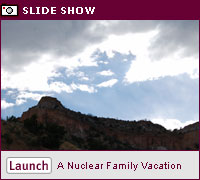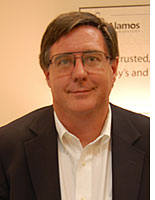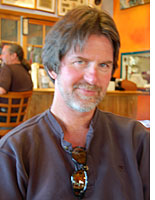A Nuclear Family Vacation
Click here to see a slide show. LOS ALAMOS, N.M.—With his starched white shirt and somber black sport coat, James Mercer-Smith, better known to his colleagues at Los Alamos National Laboratory as "Jas," looks a bit like a cross between a Protestant minister and small-town undertaker. In fact, he is, by a certain measure, one of the most powerful men on Earth.
He is a thermonuclear weapons designer, something of a rarity in a country that no longer makes nuclear weapons. The last new nuclear weapon entered the U.S. arsenal in 1987, and in 1995, the United States launched "stockpile stewardship"—an effort to maintain its current weapons indefinitely, without testing them.
Stockpile stewardship has had one troubling side effect, at least for those who think the United States must retain its ability to build nuclear weapons. As Linton Brooks, the head of the National Nuclear Security Administration told us in his office in Washington, nuclear weapons designers are now an endangered species.
"The people who have brought a weapons system from concept to fielding, who are still working at the labs, could all be carried in one bus," he told us. And with a few exceptions, Brooks added, most of those designers could "retire tomorrow."
Mercer-Smith, who came to Los Alamos in 1983, is a member of that dwindling band, and he affects a certain gravitas. As he began our interview, he thoughtfully folded his hands together as if about to say grace. The gesture seemed almost stylized, as if it had been rehearsed in a mirror for maximum effect.
"Thermonuclear weapons are wonderful weapons," he told us with an ever-so-slight smile. "It's the only one in history that has never, ever been used."
The bombs dropped on Hiroshima and Nagasaki were "fission" devices; thermonuclear weapons, which draw their power from fusion, are dramatically more powerful.
"It's never been used because we've made this Faustian bargain: We've created weapons that are so terrible that political leaders have had to think very seriously about why, how, and even whether they would want to use such weapons," he said.
Mercer-Smith is not just a designer, he's a damned good one. His three shots conducted at the Nevada Test Site were all successes. His third test, in fact, achieved something that rival Lawrence Livermore National Laboratory had tried for over 20 years, without success.
"They just didn't understand the physics as well as I did," he said with more than a hint of pride.
Part of what Mercer-Smith calls the Faustian bargain, of course, is also personal. To be a weapons designer, particularly a good one, is to take pride in doing something that is, in the classic sense of the word, quite terrible: creating weapons of mass destruction. And Mercer-Smith can recall in vivid detail the huge craters his weapons created in the Nevada desert.
"You have this odd relationship with your holes," said Mercer-Smith, again gathering his hands in front of his face. He paused to ensure he had our full attention, then continued, "I love my holes, I go visit them whenever I go to the test site."
Conscious he had said something quite provocative, and savoring our reaction, he paused for several seconds before adding, "On the other hand, in a rational way, that's a very terrifying dilemma."
What is so terrifying about holes in the Nevada desert? Well, they represent the possible end of civilization.
"I've always been interested in the plague of the 14th century," the scientist said, gazing off to the other end of the conference room, as if searching for a nonexistent window that would look out over the desert mesa. The plague swept across Europe, killing off a third of the population; but civilization marched on, Mercer-Smith said, because the fundamental infrastructure remained intact.
"Nuclear weapons are qualitatively different in that they will not only kill very large numbers of people in a very grotesque fashion, but they also destroy civilization," he said. "They will destroy that infrastructure. You can't build back. That is the frightening thing about nuclear weapons and the possibility of nuclear holocaust."
Mercer-Smith's main concern, however, is that American society has lost touch with this fact, and with it, the importance of the nuclear labs. During our visit, many at Los Alamos voiced a similar concern: that they have been forgotten and left to the whims of official Washington.
We visited Los Alamos in the middle of a crisis. Last year, laboratory Director George "Pete" Nanos ordered a complete shutdown of the lab, citing "egregious" safety and security violations, including the supposed disappearance of classified computer disks. Scientists were assigned to fill out paperwork and morale plummeted. It turned out the "missing" disks never existed.
Adding to the uncertainty, management of the lab is up for grabs. Since being founded in 1943, Los Alamos has been run by the University of California, which also holds the contract for its sister lab in California, Lawrence Livermore. Defense giant Lockheed Martin is bidding to take over what promises to be a lucrative contract, scaring employees who worry they might lose their pensions, jobs, and the uniquely academic atmosphere of Los Alamos.
As it turned out, three of the people we interviewed at Los Alamos were retiring the week we visited, including Doug Roberts, the Los Alamos computer scientist whose blog —started in a moment of quiet desperation at an Arby's off Interstate 25—was credited for helping unseat Nanos, who announced his resignation on May 6.
A scientist who visited the lab that week said the mood at Los Alamos was "like arriving in a banana republic on the day the dictator has been dispatched and all the next level, would-be dictators, are out with swords and pistols."
John Immele, deputy laboratory director for national security, said morale at Los Alamos has also been affected by what he called the "ambiguity" the nation feels about nuclear weapons. Scientists at the lab need work that they feel is not only technically challenging, but also important to the country, he told us.
And that perhaps is the most fascinating question: Can scientists who made their reputation on the size of their craters flourish in a country that tells them we shouldn't build or test new nuclear weapons?
As Mercer-Smith described it, he came to the lab in 1983 because he was concerned the best Soviet physicists were disappearing into Russia's closed nuclear cities to work on weapons, while U.S. students were pursuing academic careers. Now, Mercer-Smith said he again worries that the American public has lost touch with the threat of nuclear annihilation.
"The students who are graduating today; I don't think they have any notion of why deterrence really does matter to them and their children. … Would I come today? No, because I wouldn't have even thought of it as an important thing to do."
Endnote: Los Alamos National Bank sponsors a historical walking tour of downtown Los Alamos that includes key sites from the Manhattan Project. Stops include Fuller Lodge, Bathtub Row, and the Post Office (during World War II, mail to Los Alamos residents was sent to a post office box in Santa Fe, N.M.). For information go to the Los Alamos Historical Society Web site or contact the Los Alamos Arts Council at (505) 662-8403. Los Alamos National Laboratory also runs the Bradbury Science Museum, a public facility that features exhibits on the history of the Manhattan Project, the first use of atomic weapons, and the era of nuclear testing.


